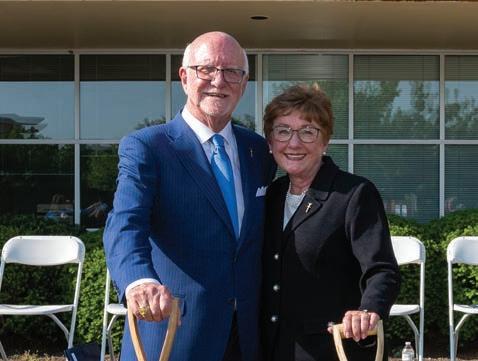
3 minute read
Using MRI to Assess the Stomach
from Summer 2022
Norman W. Kettner, DC (’80), DACBR, FICC, dean of research and professor emeritus of Logan’s Department of Radiology, recently collaborated with researchers from Massachusetts General Hospital and Harvard Medical School to publish a study titled “Non-uniform gastric wall kinematics revealed by 4D Cine magnetic resonance imaging in humans” in Neurogastroenterology & Motility. The study demonstrates how magnetic resonance imaging (MRI) can be used as a noninvasive tool to assess gastric function, including accommodation, emptying and motility.
Functional gastrointestinal (GI) disorders, also known as disorders of gut-brain interaction, number in the dozens and occur in children and adults. For example, functional dyspepsia characterized by abnormal gastric emptying and accommodation is seen in 25 percent of the world’s population. While these disorders are not caused by structural abnormalities, emerging evidence implicates an altered autonomic nervous system with sympathovagal imbalance caused by decreased parasympathetic and increased sympathetic outflow, resulting in reduced gastric motility.
Functional GI disorders are difficult to evaluate with conventional imaging techniques like computed tomography or endoscopy. Because they are unable to assess multiple aspects of gastric function at the same time, many patients must undergo several invasive tests. For example, gastric emptying scintigraphy requires radiation exposure, while antroduodenal manometry to analyze motility and accommodation involves inserting a catheter into a patient’s nose.
“The development of a noninvasive tool capable of concurrently assessing multiple aspects of GI function is highly desirable for both research and clinical assessments,” Dr. Kettner said.
In addition to their invasiveness, many techniques are limited because they are either functional or anatomical.
“It’s essential for clinicians to analyze both the anatomy and function of the stomach,” Dr. Kettner said. “An anatomical evaluation can help identify problems such as an ulcer or blockage; however, doctors also need a way to assess for functional GI disorders not caused by a structural abnormality.”
Fortunately, technological advances in MRI, which is noninvasive, have produced new tools for dynamic (or “cine”) body imaging that can be used to simultaneously evaluate multiple aspects of the stomach.
“This is just one instance where progress in one area of medicine may translate to others,” Dr. Kettner said. “Cardiac radiologists came up with MRI to study the heart in real time. Now we’re utilizing it as an effective, noninvasive way to look at the stomach.”
Fifteen healthy adults were enrolled in this study. Before being placed in an MRI scanner, they consumed a mixture of vanilla pudding and blended pineapple. The manganese in the pineapple acted as a gadolinium-free contrast agent to help the researchers distinguish between different areas of the stomach.
The team collected three fourdimensional (4D) cine-MRI scans of participants’ stomach regions 15 minutes, 45 minutes and 70 minutes after they
Dr. Norman W. Kettner finished their meals. They were able to use the scans to conduct a successful qualitative assessment of multiple gastric functions such as emptying, motility and peristalsis propagation patterns.
“Demonstrating MRI’s potential as a clinical and gastric physiology research tool represents a new era in imaging history,” Dr. Kettner said.
For Dr. Kettner and his team, this research served as a steppingstone to another paper that was recently accepted for publication in Neurogastroenterology & Motility.
“In our latest research, multimodal MRI revealed that reduced gastric peristaltic velocity was correlated to altered brainstem-cortical function (nucleus tractus solitarii and functional cortical connectivity) in patients with functional dyspepsia, indicating maladaptive neuroplasticity in gut-brain communication,” Dr. Kettner said. “We’re opening a new door in diagnostic imaging by analyzing and correlating brain activity with peripheral and visceral functions. This is truly integrative neurosystems imaging.”
Scan the QR code below to read the full study on MRI. Look for more information about Dr. Kettner’s new Neurogastroenterology & Motility paper in the fall 2022 issue of The Tower.










